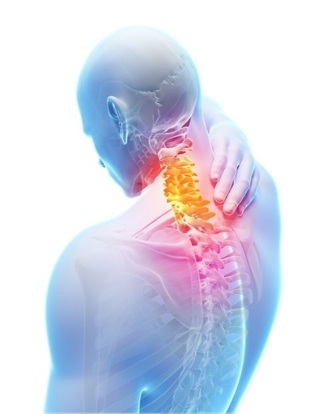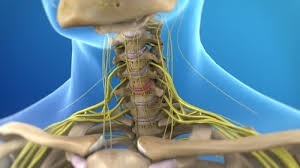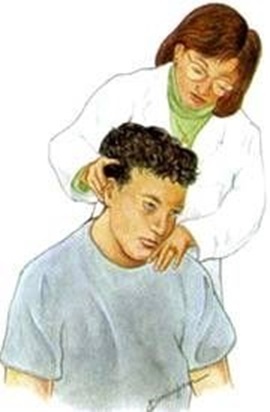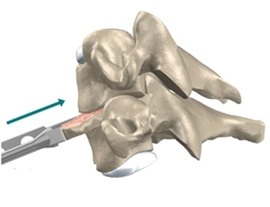Degenerative disc disease (low back pain) in the cervical spine, because of the underlying symptoms of pain in the neck and irradiiruet pain in your hands. Pain symptoms begin to manifest in the case when the un or more intervertebral discs in the cervical spine begin to collapse due to degeneration.
The predisposition of people to develop osteoarthritis may have a genetic component. Trauma can also accelerate, and sometimes cause the development of degenerative changes of the cervical spine.
Treatment of degenerative disc disease of the cervical spine with good results it gives when it has character and and regular consistent and systematic. Osteochondrosis of the cervical spine is included in the list of the causes of the most common symptoms in patients of working age who sit long at the computer. Often the patients do not pay attention to the pain and not seek medical assistance , which carries a risk of complications.
Risk Factors of degenerative disc disease of the cervical spine

While almost all people sooner or later develop involutional degenerative changes of the cervical spine, there are some factors that make it more likely that the development of degenerative diseases of early disc disease or the symptoms. These risk factors can include:
- Genetics. Some studies of twins indicate that genetics does the un play the most important role of the life style with the development of degenerative diseases of early disc disease in the cervical spine appearance and the fast of the symptoms.
- Obesity. Weight s associated with the risk of development of degenerative disc disease (osteoarthritis).
- Smoking. This pot habit to hinder the flow of nutrients to the clubs speed up and your hydration.
- In addition, a spinal cord injury sometimes that can start or speed up the process of degeneration of the cervical spine.
Symptoms
The symptoms of degenerative disc disease of the cervical spine pot for a change widely in different people.
When degenerative disc disease becomes symptomatic, may develop pain gradually or suddenly appear. The symptoms can range from some neck discomfort a debilitating serious pain that radiates in the arm, numbness and / or muscle weakness.
Main symptoms:
- Pain in the neck. Low-intensity of pain on a background of stiffness in the neck and the symptoms of Marta of degenerative disc disease of the cervical spine. However, sometimes, the pain may increase sharply I last destinations hours or days.
- Neuralgia. This type of pain tends to be sharp or with a sense of shock radiated to the shoulder of the arm, hand and / or fingers. Typically, the neuralgia and felt only on one side of the body.
- Neurological symptoms in the hand, wrist and / or fingers. You may experience sensations of tingling, stinging, numbness and / or weakness which may extend along the entire upper part of the limbs. These types of symptoms that can interfere with daily activities, for example, to print, dress up or grasping objects.
- The pain increases with movement. In General, the pain caused by degenerative disk usually increases with movement and decreases sleep.
- If the pain is coming from the degenerative disc, and likely to disappear by itself in a couple of weeks or months. However, symptoms of other degenerative disc disease of the cervical spine, become often requires chronic treatment for example, if the joints of the neck, also begin to degenerate and / or not there is a compression of nerve root.
Less common symptoms
Most of the cervical spine degenerates, and the more likely that the spinal canal is narrow and increasing the risk of compression of the spinal cord. If there is no compression of the spinal cord will develop myelopathy, and they appear symptoms such as:
- The difficulty of the hands move and / or feet
- The problems of coordination and / or balance
- The loss of control of bowel and / or bladder
- Weakness and / or numbness of any part below the neck
- Shooting pains in the limbs, can increase the that when you bend forward
Cervical myelopathy and a serious illness that requires medical attention immediately. Normally, this condition occurs in people over the age of 50 years.
Diagnosis
The diagnosis of osteochondrosis of the cervical column can be set the basis on these data as:
- The patient's medical history. First, the doctor needs to examine in detail the symptoms and medical history.
- Physical examination. Then the doctor will carry out the un's physical examination for the detection of the neck and checking for movement of the range in the neck. During the test, patients can be asked to perform certain movements and increases indicate or decreases the pain in the neck.
- If the pain or an intense if there are neurological symptoms, such as pain, feeling of weakness tingling or to the shoulder, arm or hand, then the doctor, likely prescribe it for medical imaging .
- Medical imaging (x-ray, CT, MRI, PET). If it determines that the doctor to determine the exact origin of the symptoms and necessary to obtain images of the tissues (discs), then the most likely be scheduled for magnetic RESONANCE imaging. The MRI, x-ray or perhaps ct scan can confirm if there are signs of degeneration, and other conditions to identify (such as osteoarthritis or stenosis) that can cause symptoms.
- Original works of art to confirm the un accurate diagnosis of degenerative disc disease of the cervical spine, as well as any other bound States, one can understand the Genesis of the symptoms to identify the disease m'-you treatment program.
Condition associated with degenerative disc disease of the cervical spine

The degeneration of the disc, and is accompanied often by other diseased states, and develop, either in time, or in some cases one of the causes of the other. Most often meet the following condition:
- Hernia in the cervical spine occurs in the case that the degeneration of the disk leads to an alteration of the integrity of the ring fibrous and output of content " is produced outside of the ring. But a herniated disc can produce an original work of art d injury , which, in short, accelerates the disc degeneration leads to the development of degenerative disc disease of the cervical spine .
- Cervical osteoarthritis. As soon as the disc degenerates and the disc space within the spinal column decrease begins in the joints can start to move abnormally and cause the un wear excessive of the cartilage and stimulate the formacio of osteophytes in the cervical spine.
- Cervical stenosis of the spine. This condition that occurs due to the osteophytes herniation or disk and I narrowing of the spinal canal (the spinal cord) or foraminal foramen (the nerve root).
But you should understand that sometimes, arise because some people with a narrowing of the spinal canal and the development of symptoms associated with degenerative disc disease.
Cervical radiculopathy - symptoms of pain, tingling, numbness and / or weakness radiating to the shoulder to the hand and arm can occur when the un or more nerve roots are irritated or zaselyalsya. Stricture If it occurs when the spinal cord compression by herniated disc or osteophytes, that can develop myelopathy. Possible symptoms of pain, tingling, numbness and / or weakness can be felt on this level in the neck and in any place below the level of compression. For example, it can be a person tingling, or weakness in the legs, problems with balance or even the difficulty to control the bowel and bladder.
If you have symptoms, myelopathy, and crucial to seek medical assistance because of the disease can progress, I have heard treatment can reach the palsy of developing the limbs, and dysfunction.
Treatment
As a general rule, when the symptoms due to degenerative disc disease of the cervical spine taken curative actions aimed at reducing symptoms. Mainly in the treatment of degenerative disc disease of the cervical spine uses non-surgical methods of treatment.

In exceptional cases, when the pain and the symptoms persist or several months worsen in spite of treatment, or if there are un risk of damage to the spinal cord, then the subject of The operation.
Options for a conservative treatment
To treat the neck pain caused by degenerative disc disease, the doctor recommended generally one or more of the following treatment options:
- Of vacation or a life style change. Some actions may be more for the painful neck, like the neck of the tram, forward when working at the computer. Withdrawal or change certain activities for several days, weeks usually or reduces pain. In addition, it is recommended to keep the correct posture (instead of slouching when sitting or bending the neck while driving forward, etc.). Eat healthy foods, proper hydration I quit Smoking also be useful for the health of the discs.
- Treatment of the pain or the drugs, the injections. True Un effect can give over-the-counter pain relievers. If the pain and the charm, that can be assigned to more than one strong pain drugs, such as or oral steroids, muscle relaxants and even opioid.
Injections such as facet injections, nerve or blockade epidural. Can include These injection of corticosteroids to a specific structure to reduce local inflammation:
- Epidural Caudal injections
- Injection joints
- Interlaminar epidural caudal steroid injections
- Transforaminal epidural injections
- Selective blocking of the nerve roots
- Lock branches medial
- The ice, the heat, and can be used in the treatment of degenerative disc disease of the cervical spine.
- LFK. Most non-surgical programs for the treatment of degenerative disc disease of the cervical spine includes the un programme of specific exercises such as isometric and stretching .The selection of exercises should be to carry out the un qualified professional ( doctor in physical therapy) , as an exercise wrong can lead to degradation . In addition ,the exercises must be chosen taking into account the particular characteristics of a particular person . In General, the object of the enlargement of the strength and flexibility in the neck can reduce the risk of pain a little slow and the changes in the discs degenerative.
- Manual therapy. The cervical spine can be adjusted manually by a technician competent in the field of health to improve the range of motion and / or reduce the pain. Depending on the symptoms in each patient and necessary to carry out un a physical exam and / or view before hand manipulation in the neck.
- Physical therapy
- Massage
- Acupuncture
- Corethrogyne
Surgical treatment of degenerative disc disease of the cervical spine
The level of treatment of osteochondrosis of the cervical spine it is generally considered in two cases:
- There are neurological symptoms such as the constant sensation of numbness in the hands and / or weakness, or problems with walking or control of the bowel. If neurological symptoms caused by degenerative disc disease of the cervical spine, there are un risk permanent damage to piegaro, and can be the surgery is recommended to reduce the pressure on the piegaro.
- The chronic pain and severe and do not respond to treatment for a minimum of six months of non-surgical treatment, and activities of daily living becomes difficult. Surgical Better result and expected for patients with chronic pain in combination with other diseases such as walking instability segments of the neck and / or radiculopathy.
Early surgical methods of treatment of degenerative disc disease of the cervical spine are:
- Discectomia cervical Anterior and fusion (ACDF).
- Artificial disk replacement.
In addition, there are a number of surgical techniques for the treatment of degenerative disc disease of the cervical spine:

- Endoscopic decompression
- Endoscopic and foraminotomy
- The decompression
- Intra disc used electrothermal therapy
- Selective endoscopic discectomy
- Spinal cord stimulation
- The ablation by radiofrequency
- Epidural lysis d attached
Surgical procedures on the neck to the decompression of nerve roots and / or spinal cord and, therefore, the reduction of neurological symptoms, such as pain or weakness in the hands, tends to the good remote results and positive forecast of 80% to 90% .































